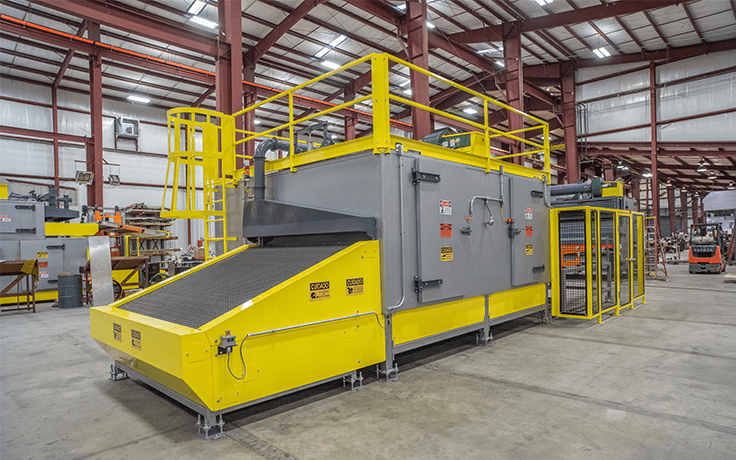Best Uses for Vertical Ovens
Manufacturers often turn to vertical ovens when they have limited floor space. After all, that’s the basic idea behind a vertical oven: By going up, a custom oven manufacturer can create an industrial oven that has a smaller footprint than a typical, horizontally oriented oven.
And while it’s true that a vertical oven can be engineered to heat treat nearly any product type (e.g., car parts of all shapes and sizes), there are definitely some products that are better suited to vertical ovens.
Think about it: Products such as non-woven fabrics, filters, and solar panels are all flat objects. If they were to be processed in quantity using a typical horizontal industrial oven, that oven would take up excessive amounts of floor space. Or, if the footprint was limited, only a few products could be processed at a time.
With flat objects, it’s simply better to heat treat them using vertical ovens. Line up products like filters or panels vertically like books on a bookshelf or stack them using custom product trays, rather than laying them out successively on a horizontal conveyor like pies in a pizza toaster oven. Or, put a roll of fabric on a roller system that goes from the floor to the ceiling, rather than stretching it across the shop floor.
Keeping these general ideas in mind, let’s take a closer look at some of the main features of vertical ovens, as well as some examples of actual vertical ovens, to get a better sense of the best uses for vertical ovens.
Main Features of Vertical Ovens
As the name indicates, vertical ovens have a vertical, rather than a horizontal orientation. Their oven chambers rise from down near the ground up toward the ceiling. By orienting their oven chambers in this way, vertical ovens have much smaller footprints than typical horizontal industrial ovens.
Usually quite tall, vertical ovens are often several times taller than a person (usually somewhere in the 15–18-foot-high range, although they can be as high as 45 feet tall). These big ovens require conveying systems, either indexed or non-indexed, to move products through the oven’s heating and cooling chambers. Typically, these conveying systems are custom roller systems (e.g., for non-woven fabrics) or include hinged custom product trays (e.g., for car parts), much like a Ferris wheel’s seats, that can transport products up and down without dropping them.
Sometimes referred to as “Ferris wheel ovens,” vertical ovens with conveyors move products in a circular pattern, rather than using a single-plane up-down motion. In this way, products can be conveyed through a series of carefully sequenced heated chambers. The circular motion also allows products to be brought back to the oven’s loading point for unloading. This can save time and labor costs by allowing the same employee to load and unload product at the same workstation.
As far as limitations are concerned, vertical ovens have very few. The main risk with vertical ovens is the possibility of nullifying the space-saving benefits of the vertical design by trying to create a vertical oven for especially bulky products that need to be processed in large quantities.
Also, remember that vertical conveyor ovens require power to lift their products, overcoming the downward pull of gravity. In cases where heavy products need to be processed, this extra load may make a vertical oven design impractical since excessive power could lead to overly high operating costs.
Example Vertical Ovens
Vertical ovens are most often used for curing, drying, and sintering. Here are a few examples from our catalog of custom industrial ovens to give you some idea of how a vertical oven design can be applied to create heat processing solutions.
DTI-948 Vertical Oven
The DTI-948 vertical oven features custom product trays for solar panel. The electric DTI-948 vertical oven is used to cure epoxy on solar panels. Loaded manually into the vertical heating chamber, the solar panels travel up and down on a conveyor featuring custom product trays as they are heated to 401° Fahrenheit. They then enter a horizontal cooling chamber where they are cured using ambient air.
DTI-1182 Vertical Oven
Used to dry a technical non-woven web product that is treated with a special solvent, the towering DTI-1182 vertical oven is 45 feet high. This mammoth vertical oven contains three solvent applicator tanks. The web sheet makes three vertical passes up and down, from applicator tank into the gas-powered heating chamber, before exiting the oven.
DTI-9280 Vertical Oven
Fifteen feet high but only three feet deep, the DTI-9280 vertical oven is designed to sinter Polytetrafluoroethylene (PTFE) on glass cloth. The cloth is conveyed through the oven with a series of rollers. To start, an automated payoff roller releases cloth into a coating batch. Then, a take-up roller pulls the coated cloth into the first oven chamber to begin the sintering process. By the time the cloth enters the third and final oven chamber, it has reached temperatures up to 850° Fahrenheit thanks to the oven’s SCR-controlled radiant heating panels.
To take a look at some more examples of custom vertical ovens and their applications, please browse the custom vertical ovens section of our catalog.
Parting Thoughts on Vertical Ovens
You’re not going to find any off-the-shelf vertical ovens built for industrial applications on the market. Which is fine, because if you’re considering a vertical oven, you probably have a very specific need and challenge — namely, limited floor space in your manufacturing facility, which has undoubtedly been organized to suit your unique production needs.
To get a better sense of what’s possible — and recommended — for your particular situation, please contact us. We’ll be happy to help you identify the best approach to addressing your heat processing needs and have extensive experience developing custom industrial ovens of all shapes and sizes, including vertical ovens as thin as three-feet wide and as tall as forty-five feet high.
